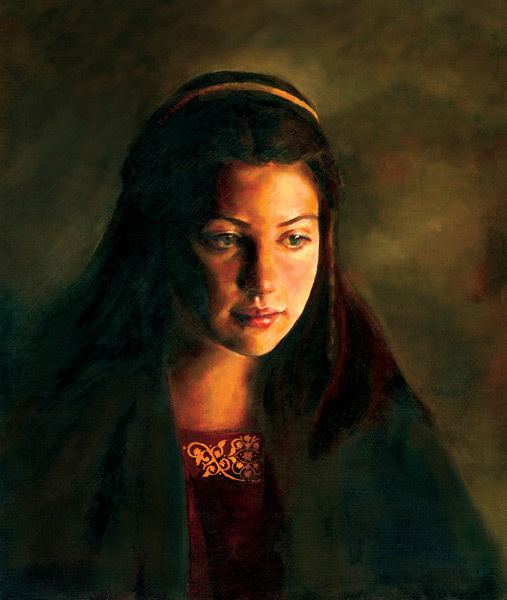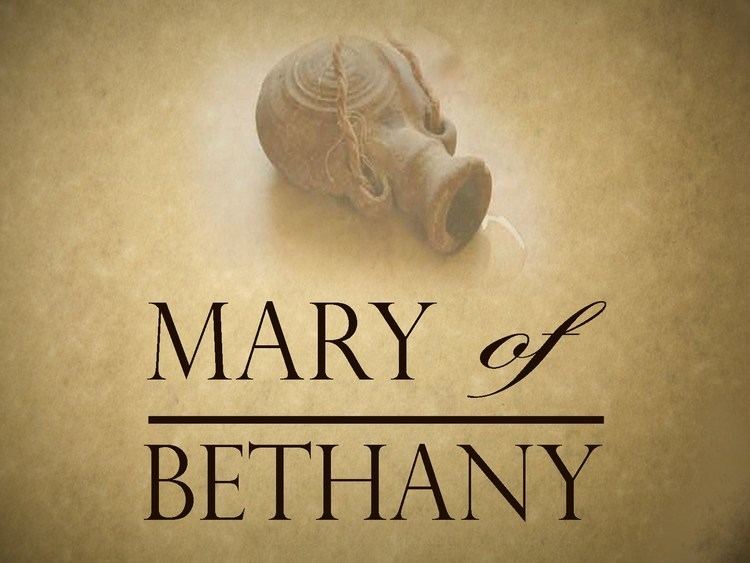 | ||
Feast June 4 (Orthodox), July 29 (Catholic/Lutheran/Anglican) Similar Martha, Mary Magdalene, Mary of Clopas, Joseph of Arimathea, Judas Iscariot | ||
Why is it significant that mary of bethany anointed jesus feet
Mary of Bethany (Judeo-Aramaic מרים, Maryām, rendered Μαρία, Maria, in the Koine Greek of the New Testament; form of Hebrew מִרְיָם, Miryām, or Miriam, "wished for child", "bitter" or "rebellious") is a biblical figure described in the Gospels of John and Luke in the Christian New Testament. Together with her siblings Lazarus and Martha, she is described by John as living in the village of Bethany near Jerusalem; in Luke only the two sisters, living in an unnamed village, are mentioned. Most Christian commentators have been ready to assume that the two sets of sisters named as Mary and Martha are the same, though this is not conclusively stated in the Gospels, and the proliferation of New Testament "Marys" is notorious.
Contents
- Why is it significant that mary of bethany anointed jesus feet
- Mary of bethany
- Medieval Western identification with Mary Magdalene
- Eastern Orthodox tradition
- Commemoration as a saint
- References

Medieval Western Christianity identified Mary of Bethany with Mary Magdalene and with the sinful woman of Luke 7:36–50. This influenced the Roman Rite liturgy of the Feast of Mary Magdalene, with a gospel reading about the sinful woman and a collect referring to Mary of Bethany. Since the 1969 revision of that liturgy, Mary Magdalene's feast day continues to be on 22 July, but Mary of Bethany is celebrated, together with her brother Lazarus, on 29 July, the memorial of their sister Martha. In Eastern Christianity and some Protestant traditions, Mary of Bethany and Mary Magdalene are considered separate people. The Orthodox Church has its own traditions regarding Mary of Bethany's life beyond the gospel accounts.

Mary of bethany
Medieval Western identification with Mary Magdalene

In medieval Western tradition, Mary of Bethany was identified as Mary Magdalene perhaps in large part because of a homily given by Pope Gregory the Great where he taught about several women in the New Testament as though they were the same person. This led to a conflation of Mary of Bethany with Mary Magdalene as well as with another woman (beside Mary of Bethany who anointed Jesus), and the woman caught in adultery. Eastern Christianity never adopted this identification. In his article in the 1910 Catholic Encyclopedia Hugh Pope stated, "The Greek Fathers, as a whole, distinguish the three persons: the 'sinner' of Luke 7:36–50; the sister of Martha and Lazarus, Luke 10:38–42 and John 11; and Mary Magdalen.

Hugh Pope enumerated the accounts of each of these three persons (the unnamed "sinner", Mary Magdalene, and Mary of Bethany) in the Gospel of Luke and concluded that, based on these accounts, “there is no suggestion of an identification of the three persons, and if we had only Luke to guide us we should certainly have no grounds for so identifying them [as the same person].” He then explains first the position, at that time general among Catholics, equating Mary of Bethany with the sinful woman of Luke by referring to John 11:2, where Mary is identified as the woman who anointed Jesus, and noting that this reference is given before John's account of the anointing in Bethany:

John, however, clearly identifies Mary of Bethany with the woman who anointed Christ's feet (12; cf. Matthew 26 and Mark 14). It is remarkable that already in John 11:2, John has spoken of Mary as "she that anointed the Lord's feet", he aleipsasa. It is commonly said that he refers to the subsequent anointing which he himself describes in 12:3–8; but it may be questioned whether he would have used he aleipsasa if another woman, and she a "sinner" in the city, had done the same. It is conceivable that John, just because he is writing so long after the event and at a time when Mary was dead, wishes to point out to us that she was really the same as the "sinner." In the same way Luke may have veiled her identity precisely because he did not wish to defame one who was yet living; he certainly does something similar in the case of St. Matthew whose identity with Levi the publican (5:7) he conceals. If the foregoing argument holds good, Mary of Bethany and the "sinner" are one and the same.
Hugh Pope then explained the identification of Mary of Bethany with Mary Magdalene by the presumption that, because of Jesus’ high praise of her deed of anointing him, it would be incredible that she should also not have been at his crucifixion and resurrection. Since Mary Magdalene is reported to have been present on those occasions, by this reasoning, she must therefore be the same person as Mary of Bethany:
An examination of John's Gospel makes it almost impossible to deny the identity of Mary of Bethany with Mary Magdalen. From John we learn the name of the "woman" who anointed Christ's feet previous to the last supper. We may remark here that it seems unnecessary to hold that because Matthew and Mark say "two days before the Passover", while John says "six days" there were, therefore, two distinct anointings following one another. John does not necessarily mean that the supper and the anointing took place six days before, but only that Christ came to Bethany six days before the Passover. At that supper, then, Mary received the glorious encomium, "she hath wrought a good work upon Me...in pouring this ointment upon My body she hath done it for My burial...wheresoever this Gospel shall be preached...that also which she hath done shall be told for a memory of her." Is it credible, in view of all this, that this Mary should have no place at the foot of the cross, nor at the tomb of Christ? Yet it is Mary Magdalen who, according to all the Evangelists, stood at the foot of the cross and assisted at the entombment and was the first recorded witness of the Resurrection. And while John calls her "Mary Magdalen" in 19:25, 20:1, and 20:18, he calls her simply "Mary" in 20:11 and 20:16.
French scholar Victor Saxer dates the identification of Mary Magdalene as a prostitute, and as Mary of Bethany, to a sermon by Pope Gregory the Great on September 21, 591 A.D., where he seemed to combine the actions of three women mentioned in the New Testament and also identified an unnamed woman as Mary Magdalene. In another sermon, Gregory specifically identified Mary Magdalene as the sister of Martha mentioned in Luke 10. But according to a view expressed more recently by theologian Jane Schaberg, Gregory only put the final touch to a legend that already existed before him.
Western Christianity's identification of Mary Magdalene and Mary of Bethany was reflected in the arrangement of the General Roman Calendar, until this was altered in 1969, reflecting the fact that by then the common interpretation in the Catholic Church was that Mary of Bethany, Mary Magdalene and the sinful woman who anointed the feet of Jesus were three distinct women.
Eastern Orthodox tradition
In Orthodox Church tradition, Mary of Bethany is honored as a separate individual from Mary Magdalene. Though they are not specifically named as such in the gospels, the Orthodox Church counts Mary and Martha among the Myrrh-bearing Women. These faithful followers of Jesus stood at Golgotha during the Crucifixion of Jesus and later came to his tomb early on the morning following the Sabbath with myrrh (expensive oil), according to the Jewish tradition, to anoint their Lord's body. The Myrrhbearers became the first witnesses to the Resurrection of Jesus, finding the empty tomb and hearing the joyful news from an angel.
Orthodox tradition also relates that Mary's brother Lazarus was cast out of Jerusalem in the persecution against the Jerusalem Church following the martyrdom of St. Stephen. His sisters Mary and Martha fled Judea with him, assisting him in the proclaiming of the Gospel in various lands. The three later moved to Cyprus, where Lazarus became the first Bishop of Kition (modern Larnaca). All three died in Cyprus.
Commemoration as a saint
In the Catholic Church, Mary of Bethany is celebrated, together with her brother Lazarus, on 29 July, the memorial of their sister Martha.
29 July is the date of her commemoration also in the Calendar of Saints of the Lutheran Church (together with Martha and Lazarus); and in the Calendar of saints of the Episcopal Church and the Church of England (together with Martha).
She is commemorated in the Eastern Orthodox and Byzantine Rite Eastern Catholic Churches with her sister Martha on 4 June, as well as on the Sunday of the Myrrhbearers (the Third Sunday of Pascha). She also figures prominently in the commemorations on Lazarus Saturday (the day before Palm Sunday).
